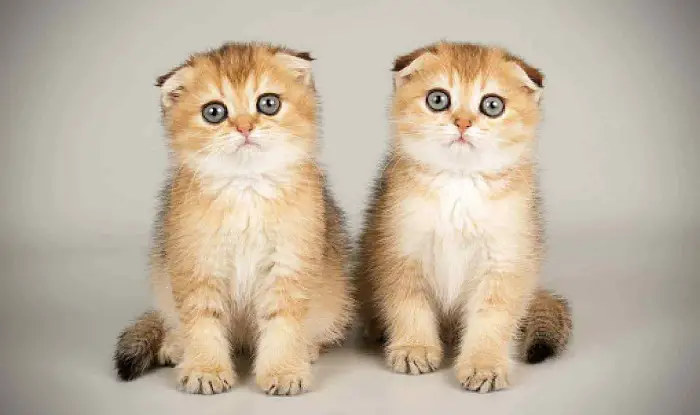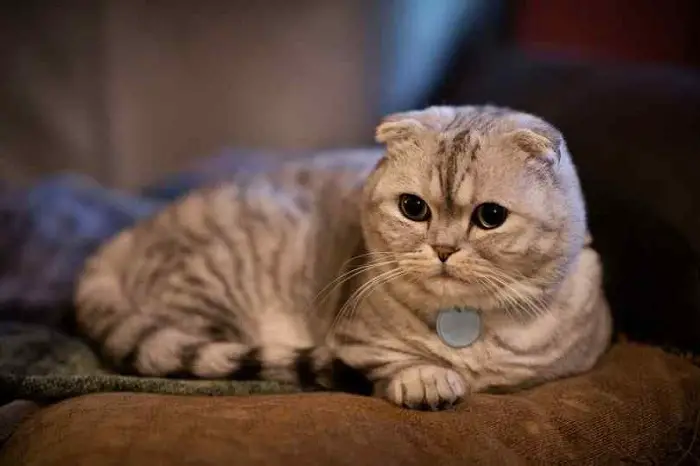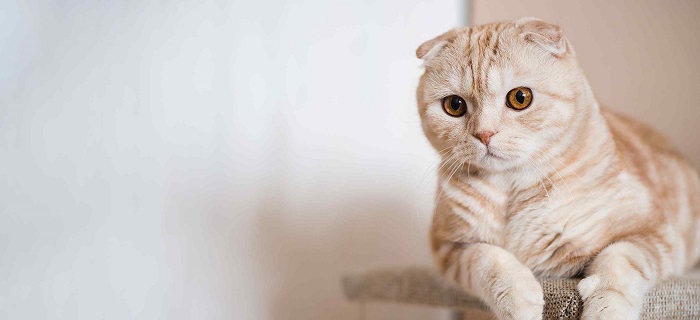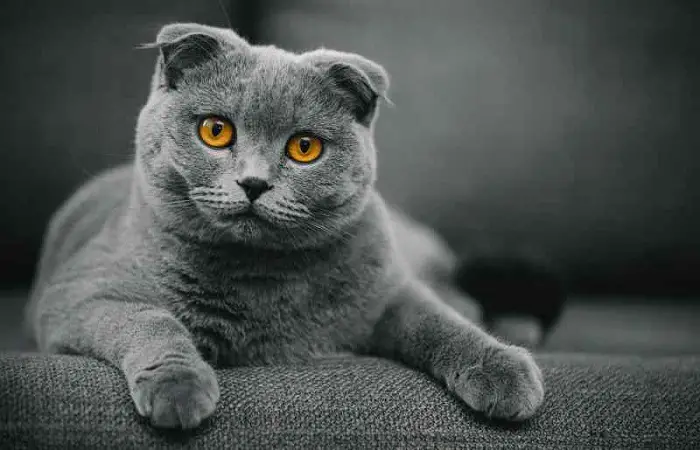The Scottish Fold cat is a distinctive and popular cat breed known for its unique folded ears. The breed originated in Scotland in the 1960s when a cat named Susie was discovered with a natural mutation that caused her ears to fold forward and downward.
The folded ears give Scottish Folds their adorable and distinctive appearance, making them quite recognizable among other cat breeds. However, it’s important to note that not all Scottish Folds have folded ears. Some cats in the breed have straight ears, known as “Highland Folds” or “Straight Folds.” The ear type depends on whether the cat has inherited one or two copies of the folded ear gene.
Origin and History of Scottish Fold Cat
The Scottish Fold cat’s origin can be traced back to Scotland in the early 1960s. The breed’s unique feature, the folded ears, results from a spontaneous genetic mutation. The story begins with a white barn cat named Susie, who lives on a farm in Perthshire, Scotland. Susie was known for having distinctive folded ears, which gave her a charming and unusual appearance.
In 1961, Susie caught the attention of a local shepherd named William Ross. Intrigued by the cat’s appearance, Ross took her home and later acquired one of Susie’s kittens, a female named Snooks, who also had folded ears. Ross noticed the trait was passed down to subsequent generations, indicating that the ear folding was likely genetically inherited.
The Scottish Fold breed was developed through the efforts of William Ross and later Pat Turner, a cat enthusiast. They carefully bred the cats to preserve the unique folded ear trait while ensuring their overall health and temperament. In 1966, the breed was officially recognized by the United Kingdom’s Governing Council of the Cat Fancy (GCCF).
In the 1970s, Scottish Folds gained international popularity, with breeders and enthusiasts worldwide working to establish and promote the breed in various cat associations. However, the breed faced some controversy early on due to concerns about potential ear-related health issues. Some cats with folded ears exhibited skeletal deformities that could cause joint problems and pain. Responsible breeding practices were emphasized to address these concerns to prevent producing cats with severe skeletal issues.
As a result, outcrossing with other breeds, like the American Shorthair and British Shorthair, was introduced to diversify the gene pool and reduce the risk of hereditary health problems. This crossbreeding was conducted while maintaining the folded ear trait, and as a result, Scottish Folds with straight ears (Highland Folds/Straight Folds) can also be found today, as they carry one copy of the folded ear gene.
Various cat registries and associations worldwide recognize the Scottish Fold breed, including The International Cat Association (TICA) and the Cat Fanciers’ Association (CFA). Today, Scottish Folds are a famous and beloved breed known for their charming appearance, sweet temperament, and affectionate nature. Responsible breeding practices continue to be essential to ensuring the health and well-being of the breed.
Physical Features of Scottish Fold Cat
The Scottish Fold cats are known for their distinctive and charming appearance, primarily due to their unique folded ears. However, apart from their ears, Scottish Folds possess other physical features contributing to their overall appeal. Here are some key physical characteristics of the Scottish Fold cat:
- Folded Ears: The most defining feature of the Scottish Fold is its folded ears, which gives the breed its name. The ears fold forward and downward, creating a rounded and cute appearance. Not all Scottish Folds have folded ears; some have straight ears, known as “Highland Folds” or “Straight Folds.” The ear type depends on the cat’s genetics, as it requires inheriting one or two copies of the folded ear gene.
- Head: Scottish Folds have a rounded head with full cheeks, giving them a sweet and expressive facial expression. Their faces may seem chubby and endearing.
- Eyes: Their large, round, expressive eyes contribute to their affectionate, endearing look. Eye color can vary and includes shades of gold, copper, green, and blue, depending on the cat’s coat color.
- Body: Scottish Folds have a medium-sized body with a sturdy build. They are well-muscled but not overly heavy.
- Coat: The breed can have both short and longhaired varieties. The short-haired Scottish Fold has a dense and plush coat, while the longhaired variant (the Scottish Fold Longhair or Highland Fold) has a luxurious and flowing coat.
- Tail: Scottish Folds have a medium-length tail that tapers at the end. The tail is proportional to the body and is often carried low.
- Legs and Paws: Their legs are of medium length and well-proportioned. Their paws are rounded and often have tufts of fur between the toes.
- Whiskers: Scottish Folds often have short and curved whiskers, which adds to their cute and distinctive appearance.
Height, Weight, and Lifespan of Scottish Fold Cats
The height and weight of Scottish Fold cats can vary depending on their gender and overall size, but they are generally considered medium-sized cats. Here are some average measurements:
- Height: Scottish Folds typically stand around 8 to 10 inches (20 to 25 cm) long at the shoulder.
- Weight: The average weight of a Scottish Fold cat is between 9 to 13 pounds (4 to 6 kg) for males and 6 to 9 pounds (3 to 4 kg) for females. However, there can be variations; some individuals may be larger or smaller.
- Lifespan: On average, Scottish Fold cats can live between 12 to 15 years. As with any breed, the lifespan of an individual cat can be influenced by genetics, diet, exercise, and access to regular veterinary care.
Colors of Scottish Fold Cat
Scottish Fold cats are found in various colors and patterns, making them more attractive and diverse. The breed’s coat colors can be classified into several categories, and various patterns can be within each category. Here are some of the standard coat colors and patterns found in Scottish Fold cats:
- Solid Colors: These are cats with uniform color throughout their coat. Standard solid colors in Scottish Folds include:
- Black
- White
- Blue (a bluish-gray color)
- Red (often referred to as “orange” or “ginger”)
- Cream (a lighter version of red)
- Tabby Patterns: Tabby patterns are characterized by distinct stripes, swirls, or spots on the cat’s coat. Some common tabby patterns in Scottish Folds are:
- Classic Tabby (swirled patterns)
- Mackerel Tabby (narrow stripes)
- Spotted Tabby (spots instead of stripes)
- Bicolor: Bicolor cats have a coat with two primary colors, typically white and another color. The color is usually distributed in specific patterns on the body, with a significant amount of white on the paws, belly, chest, and face.
- Colorpoint: Colorpoint cats have a lighter body color with darker coloration on the ears, face, paws, and tail. The contrast between the body color and the points is particularly striking.
- Tortoiseshell: Tortoiseshell cats, also known as “torties,” have a unique mix of black and orange (or cream) colors in their coat. These colors are often mixed in a mottled or brindled pattern.
- Calico: Calico cats have a combination of white, black, and orange (or cream) colors in their coat. Like tortoiseshells, the colors are often mixed in a mottled or brindled pattern.
- Silver: Silver Scottish Folds have a white coat with black tipping on the fur, giving them a beautiful shimmering appearance.
- Smoke: Smoke cats have a solid color base, but the individual hair shafts are tipped with a lighter color, creating a smoke-like effect.
The Behavior and Temperament of Scottish Fold Cats
Scottish Fold cats are renowned for their sweet and gentle temperament, making them delightful and affectionate companions. Here are some common behavioral traits and temperament characteristics of Scottish Fold cats:
- Affectionate: Scottish Folds are known for their loving and cuddly nature. They enjoy being close to their human family members and often seek out attention and affection. They are likely to become loyal and devoted to their owners.
- Gentle and Calm: Scottish Folds are generally calm and easy-going cats. They tend to have a laid-back demeanor and adapt well to various living situations, making them suitable for families and individuals.
- Social: Scottish Folds are social cats and usually get along well with other pets and family members. They are not typically aloof or overly independent but prefer to participate in household activities.
- Playful: Despite their relaxed nature, Scottish Folds do enjoy playtime. They may engage in interactive play with their owners or entertain themselves with toys and activities.
- Quiet: Scottish Folds are not known for being excessively vocal. While they may express themselves with soft meows and chirps, they are generally not as talkative as other breeds.
- Curious: Like many cats, Scottish Folds are curious creatures. They may investigate new objects or areas in their environment, displaying a natural feline curiosity.
- Easy to Handle: Due to their gentle and calm nature, Scottish Folds are usually easy to handle and are well-suited for families with children. However, as with any cat, it’s essential to teach children how to interact with them respectfully and gently.
- Indoor Cats: Scottish Folds are well-suited to indoor living. Their folded ears can be more susceptible to environmental hazards, and keeping them indoors can help protect them from potential injuries or infections.
- Attention Seekers: Scottish Folds often seek attention from their owners and may follow them around the house. They may also enjoy sitting on their owner’s lap or snuggling beside them.
- Relaxed Posture: Scottish Folds are known for their relaxed and “floppy” posture when sitting or lying down. Their folded ears give them a unique appearance, adding to their charm.
Food and Nutrition of Scottish Fold Cat
Proper food and nutrition are essential for the health and well-being of Scottish Fold cats. A balanced and nutritious diet helps maintain their overall health, supports their immune system, and keeps their coat and skin in good condition. Here are some important considerations regarding the food and nutrition of Scottish Fold cats:
- High-Quality Cat Food: Choose a portion of high-quality cat food specifically formulated for your cat’s life stage (kitten, adult, or senior) and meets their nutritional needs. Look for a reputable cat food brand that uses natural animal protein as the primary ingredient and provides essential nutrients.
- Protein in Cat Diet: Cats are obligate carnivores, requiring a diet rich in animal-based protein. Look for cat food with a high percentage of protein, preferably from sources like chicken, turkey, or fish.
- Fat: Fats are an essential energy source for cats, contributing to healthy skin and a shiny coat. Ensure the cat food contains an appropriate amount of healthy fats.
- Carbohydrates: While cats don’t require carbohydrates as a primary nutrient, some cat foods include them as a source of energy. However, it’s best to choose cat foods with limited carbohydrate content, as cats cannot digest carbohydrates.
- Avoid Fillers: Avoid cat foods containing excessive fillers, artificial additives, or by-products. These may not provide adequate nutrition, leading to weight gain, obesity, or other health issues.
- Wet vs. Dry Food For Cats: Both wet and dry cat food suit Scottish Fold cats. Wet food provides additional hydration and can benefit cats that don’t drink much water. Dry food can help keep their mouths clean. Some cat owners choose to offer a combination of both wet and dry food.
- Portion Control: Overfeeding can lead to obesity, harming a cat’s health. Follow the feeding schedule on the cat food packaging, and consider your cat’s activity level and metabolism.
- Fresh Water: Always provide fresh, clean water for your Scottish Fold cat to keep them hydrated.
- Special Dietary Needs: If your Scottish Fold has specific dietary requirements or health issues, consult your veterinarian to determine the best diet plan.
- Avoid Toxic Foods: Some human foods are toxic to cats, such as chocolate, onions, garlic, grapes, raisins, and certain artificial sweeteners. Never feed your cat these items.
Care and Management of Scottish Fold Cats
Caring for a Scottish Fold cat involves providing them with proper nutrition, grooming, regular veterinary check-ups, and creating a safe and loving environment. Here are some essential aspects of care and management for Scottish Fold cats:
- Nutrition: Feed your Scottish Fold a balanced, high-quality cat food that meets their nutritional needs. Choose cat food appropriate for their age, size, and health condition. Provide fresh water at all times.
- Grooming: Regularly groom your Scottish Fold to keep their coat clean and healthy. Brush their fur (especially for longhaired variants) to prevent matting and reduce shedding. Grooming also allows you to check for any skin issues or parasites.
- Litter Box: Provide a clean litter box for your Scottish Fold and keep it in a quiet and accessible location. Clean the cat’s litter box daily and change the litter regularly to maintain cleanliness.
- Indoor Living: Due to their unique ear structure, Scottish Folds are generally better suited for indoor living to protect them from potential injuries or infections. Create an enriched indoor environment with toys, scratching posts, and places to climb and explore.
- Regular Veterinary Check-ups: Schedule regular veterinary check-ups for your Scottish Fold to monitor their health, vaccinations, and dental care. Cats are experts at hiding signs of illness, so regular check-ups are crucial for early detection and prevention of health issues.
- Socialization: Socialize your Scottish Fold from a young age to help them become well-adjusted and comfortable around people, other pets, and different environments.
- Exercise: Engage your Scottish Fold in regular play and exercise to stimulate them physically and mentally. Use interactive toys to encourage their natural hunting instincts.
- Dental Care: Dental health is essential for cats. Brush your cat’s teeth regularly, and consider providing dental instruments or toys to help keep their teeth clean.
- Spaying/Neutering: Unless you plan to responsibly breed your cat, spaying or neutering your Scottish Fold is recommended to prevent unwanted litters and potential health issues.
- Environmental Enrichment: Provide plenty of scope for mental and physical stimulation. Interactive play, puzzle toys, and scratching posts can help keep your cat engaged and happy.
- Attention and Affection: Spend quality time with your Scottish Fold, offering affection, cuddles, and attention. Scottish Folds are known for their affectionate nature and thrive on human interaction.
- Safety: Ensure that your home is safe for your cat. Remove potential hazards, keep toxic substances out of reach, and secure windows and balconies to prevent accidents.
The Health of Scottish Fold Cat
The health of Scottish Fold cats is a significant concern due to the genetic mutation responsible for their characteristic folded ears. The ear mutation can sometimes lead to skeletal issues, and therefore, responsible breeding practices are crucial to minimize the risk of hereditary health problems. Here are some health considerations specific to Scottish Fold cats:
- Ear Issues: The folded ear gene can lead to ear-related health problems in some Scottish Folds, such as ear infections, ear mites, and wax buildup. Regular ear cleaning and routine veterinary check-ups can help prevent and manage these issues.
- Skeletal Issues: Some Scottish Folds may develop skeletal abnormalities due to the genetic mutation that affects their cartilage. This can lead to joint problems and discomfort. It’s important for breeders to carefully select mating pairs to minimize the risk of severe skeletal issues in kittens.
- Osteochondrodysplasia: This condition is related to the breed’s genetics and can cause bone and cartilage development changes. Responsible breeding practices can help reduce the prevalence of this condition.
- Hypertrophic Cardiomyopathy (HCM): HCM is a typical cat heart condition and can also affect Scottish Folds. Regular veterinary check-ups can help monitor heart health.
- Obesity: Like any other cat breed, Scottish Folds can be prone to obesity if overfed or not given enough exercise. Maintaining a healthy weight is essential for their overall well-being.
- Dental Issues: Dental care is crucial for all cats, and Scottish Folds are no exception. Regular dental check-ups, teeth brushing, and dental treats can help prevent dental problems.
- Respiratory Issues: Some Scottish Folds may have short, flat faces (brachycephalic) due to crossbreeding with other breeds like Persians. This can lead to respiratory issues, especially in extreme cases.
- Allergies: Some Scottish Folds may be prone to skin allergies or food intolerances. Identifying and avoiding allergens can help manage these issues.
The Popularity of Scottish Fold Cat
As of my last knowledge update in September 2021, the Scottish Fold cat breed had gained significant popularity worldwide. They are recognized as one of the most beloved and sought-after cat breeds due to their unique and adorable appearance and sweet and affectionate temperament. The following factors contributed to the popularity of the Scottish Fold:
- Distinctive Appearance: The folded ears of Scottish Folds set them apart from other cat breeds, making them easily recognizable and endearing to cat enthusiasts.
- Internet Sensation: Scottish Folds gained widespread attention and popularity on social media platforms like Instagram and YouTube. Their cute photos and videos went viral, attracting even more attention and interest in the breed.
- Gentle Temperament: Scottish Folds are known for their gentle, friendly, and loving nature, which makes them excellent companions for families, individuals, and even other pets.
- Celebrity Ownership: Several celebrities and influencers have shared their love for Scottish Fold cats on social media, further elevating the breed’s popularity.
- Variety of Coat Colors and Patterns: Scottish Folds come in various coat colors and patterns, appealing to diverse tastes and preferences.
- Global Recognition: Scottish Folds are recognized by various cat associations and registries worldwide, including The International Cat Association (TICA) and the Cat Fanciers’ Association (CFA), contributing to their global popularity.
Final Talk on Scottish Fold Cats
Scottish Fold cats are undeniably captivating and unique feline companions with charming appearances and endearing personalities. Their folded ears set them apart from other breeds, making them a sought-after choice for cat enthusiasts worldwide.
Scottish Fold cats have captured the hearts of many cat lovers with their delightful personalities and distinctive appearance. However, adopting any pet comes with responsibilities, and it’s crucial to prioritize their health, well-being, and happiness. If you welcome a Scottish Fold into your family, you’ll likely find a devoted and loving companion that will enrich your life for years.



